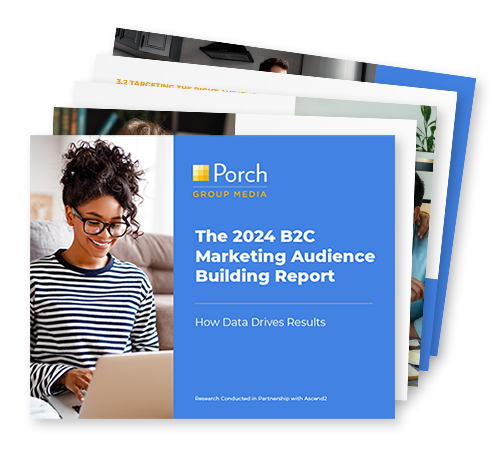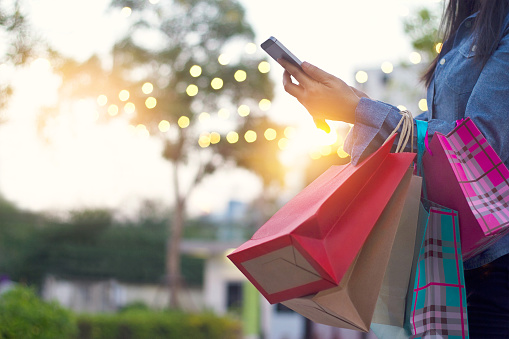Consumer shopping behaviors have shifted radically in response to the pandemic, higher prices, and low inventory from shipping and manufacturing strains. In turn, brands have responded with rapid digital transformation to meet the changing needs of today’s shoppers.
As you consider your marketing strategies, here’s a look at 25 stats on the state of consumer shopping today so you can better understand how consumers are shopping and which channels they are using.
Consumers & Online Shopping Trends
Online shopping has become a lifestyle – and continues to grow at exponential rates. The pandemic may have accelerated the rate of online shopping, but the ease of researching, buying, shipping and the huge availability of options that both small retailers to large brands offer is keeping consumers content as they peruse and spend via online channels.
- In fact, in a report by Stackla, 67 percent of consumers said their online purchasing increased since the start of the pandemic and 27 percent of people said their online shopping has increased a lot. (Stackla, 2021)
- Additionally, consumers plan to maintain these online shopping habits with 91 percent saying they’re likely to continue purchasing more items online in the future—and 52 percent saying they’re very likely to do so. (Stackla, 2021)
- The survey also revealed that 59 percent of consumers reported having purchased from new brands since the pandemic started—75 percent of which say they’re likely to continue purchasing from those new brands in the future. (Stackla, 2021)
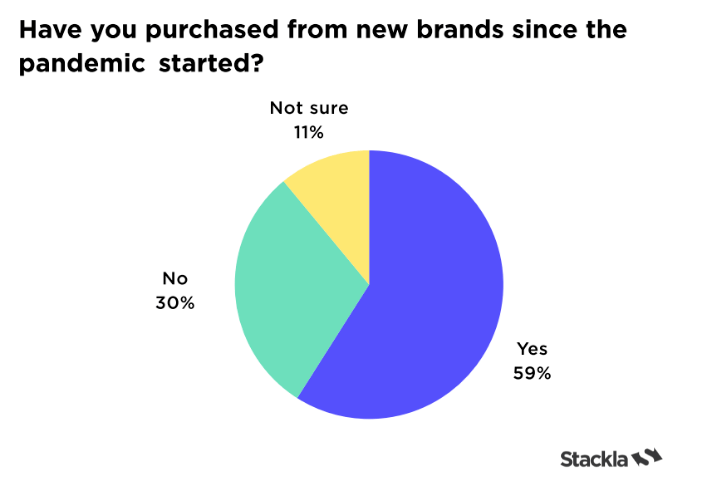
- Similiar research findings also show the lack of brand loyalty as consumers switch physically purchased brands with online competitors. 48.7% of respondents have “replaced products [they] previously purchased regularly at physical stores with online…alternatives”. (Raydiant, 2021)
- Consumers also like hybrid options of online and in-store shopping such as curbside pickup or Buy Online Pickup in Store (BOPIS). For example, Millennials were 42% more likely to express interest in curbside pickup than Boomers, and more than 50% likely (53%) to express interest in BOPIS than Boomers.
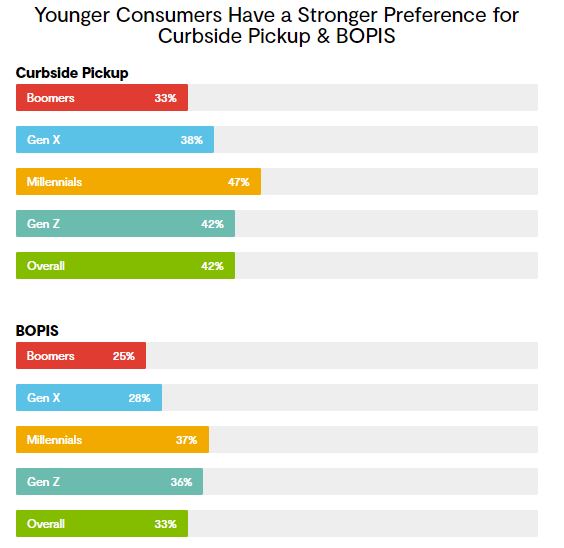
Brick and Mortar
Despite the rapid growth of ecommerce, many consumers still prefer to shop in stores.
- In a survey by Raydiant, 46% of respondents said that given the choice, they prefer to shop in person rather than online. (Raydiant, 2021)
- Customers also prefer the experience of interacting directly with products. 33% of respondents prefer shopping at physical stores because they like to see and feel products, while 26% enjoy the overall experience of shopping in person. (Raydiant, 2021)
- The good news is that brands are improving the offline experience. 29.8% of respondents said in-location customer service has gotten better in the past year. (Raydiant, 2021)
- And these positive offline experiences can make a difference. 90% of consumers say they are more likely to return again, 61% of consumers say they are likely to spend more at a location and 65% of consumers say they are likely to spend more online with a brand — all if they have a positive offline experience. (Raydiant, 2021)
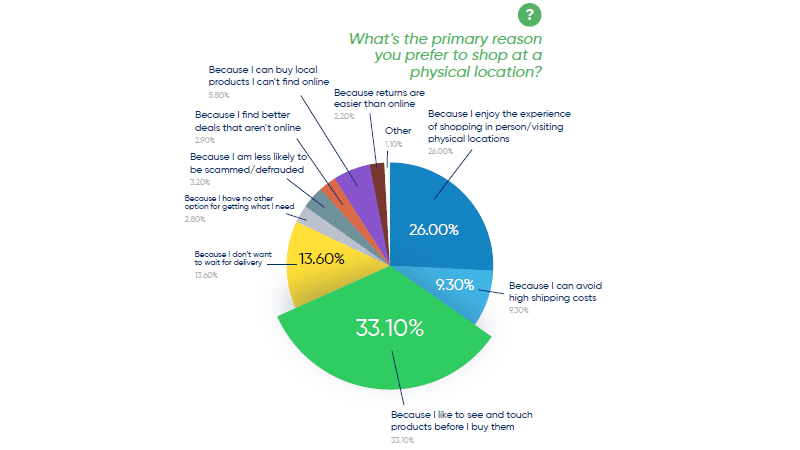
Customer Experience
Customer experience had long been a concept on which brands must compete, but in today’s changing environment and with consumers switching brands more frequently, brands must ramp up their strategies to make the customer experience a true competitive differentiator.
- 80% of customers say the experience a company provides is as important as its products and services. Expectations for the customer experience have never been higher — to acquire new customers, retailers need to meet them. (Salesforce)
- The overwhelming majority of consumers (88 percent) say authenticity is important when deciding which brands they like and support—with 50 percent saying authenticity is very important to them. (Stackla, 2021)
- In a PwC study, about two-thirds (65%) of respondents in the US feel that a positive experience with a brand is more influential than great advertising. Unfortunately, only half (49%) say that companies are providing a good customer experience today. (PwC)
- A moderate improvement in CX would impact the revenue of a typical $1 billion company an average of $775 million over three years. (Temkin Group)
- 67% of consumers and 74% of business buyers say they’ll pay more for a great experience. (Salesforce)
- Organizations that lead in CX outperformed laggards on the S&P 500 index by nearly 80%. They retain a higher share of wallet and have customers that are seven times more likely to purchase more from the company, eight times more likely to try other products or services, and fifteen times more likely to spread positive word of mouth. (Qualtrics)
Social Commerce
Social shopping, or social commerce, is the coming together of online shopping and social media channels such as Facebook, Instagram, Twitter and Pinterest. Social channels have integrated seamless shopping and purchase functionality into their platforms, making it easier for brands to sell on social networks. Social commerce attracted investment from US companies at the start of the pandemic, in addition to online and mobile commerce.
- 8 in 10 ten US businesses anticipate selling on social media within the next three years. (Statista, 2021)
- The number of US social commerce buyers grew to 80.1 million in 2020 and is anticipated to increase to 96.1 million in 2022. (eMarketer, 2021)
- According to data compiled by Big Commerce, focusing on the US market, 30 percent of online shoppers would be likely to make a purchase through a social media network. Among millennials, this proportion increases to 51%. (Big Commerce)
- Almost three out of ten consumers (29%) would be likely to follow a brand on Facebook, while 20 percent would be likely to make a purchase from the social network. (Big Commerce)
- According to statistics from Pinterest itself, 73 percent of users believe content from brands makes the platform more useful, while 61 percent have made a purchase after seeing business content on the site. (Pinterest)
- 88% of online customers are less likely to buy from companies that leave their social media complaints unanswered. Furthermore, nearly half (46 percent) of users expect brands to provide customer service on Facebook. (Neil Patel)
Mobile Commerce
With a huge percentage of internet traffic now coming from a mobile device, more and more consumers are using their mobile devices to shop online. Brands need to make sure they have optimized for mCommerce to capitalize on today’s opportunities.
- 60% of online retail website visits come from mobile devices. (Adobe, 2021)
- With over $190 billion spent on smartphone devices in 2020, mobile accounts for 40% of all online sales, and this number will surpass 50% by 2022. (Adobe, 2021)
- 70% of mobile searches lead to action within an hour. (Forbes)
- 67% of consumers admit to “digital window shopping” for fun on their smartphones, with 77% of those making impulse purchases when they do. (Paypal)
- 51% of smartphone users have purchased from a company other than the one they originally intended to because of information provided at the moment they needed it. (Google)


